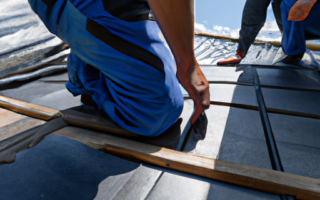Factors to Consider for Energy Efficient Flat Roofing
When it comes to energy efficiency and flat roofing, there are several factors that you should consider. Flat roofs offer unique opportunities for energy efficiency, but also present their own set of challenges. By paying attention to these key factors, you can ensure that your flat roof is not only energy efficient but also durable and long-lasting.
The first factor to consider is insulation. Proper insulation is crucial for energy efficiency, as it helps to reduce heat transfer and keep your building cool in the summer and warm in the winter. There are various insulation options available for flat roofs, including rigid foam insulation, spray foam insulation, and fiberglass insulation. The choice of insulation material will depend on factors such as your climate, building codes, and budget.
Another important consideration is the roofing material itself. Opting for a light-colored or reflective roofing material can greatly increase energy efficiency by reflecting sunlight and reducing heat absorption. White or light-colored single-ply membranes, such as TPO or PVC, are popular choices for energy-efficient flat roofs. These materials also have high solar reflectance and thermal emittance ratings, which further enhance their energy-saving properties.
Ventilation is another key factor that can significantly impact the energy efficiency of your flat roof. Good ventilation helps to regulate the temperature and moisture levels in the roof assembly, preventing the buildup of heat and condensation. A well-designed ventilation system can reduce the strain on your HVAC system and contribute to lower energy costs.
Maintenance and regular inspections are essential for ensuring the energy efficiency of your flat roof in the long run. Any issues such as leaks or damage should be promptly addressed, as they can compromise the insulation and overall performance of the roof. Regular cleaning and removal of debris also play a role in maintaining the energy efficiency of the roof by preventing clogs and blockages.
Lastly, it’s important to consider the overall design and layout of the building when aiming for energy efficiency. Factors such as the placement of windows, shading devices, and rooftop equipment can all affect the performance of the flat roof. Collaborating with architects and engineers who have experience in energy-efficient design can help you optimize not only your flat roof but also the entire building’s energy performance.
In conclusion, energy efficiency and flat roofing go hand in hand. By considering factors such as insulation, roofing materials, ventilation, maintenance, and overall design, you can maximize the energy-saving potential of your flat roof. Investing in energy-efficient flat roofing not only benefits the environment but also your bottom line, by reducing energy consumption and lowering utility costs over time.
Optimizing Energy Efficiency in Flat Roofing Installation
When it comes to energy efficiency in flat roofing installation, there are several important factors that should be taken into consideration. Not only can an energy-efficient flat roof help reduce energy consumption, but it can also contribute to a more comfortable indoor environment and lower utility bills. Here are some key aspects to consider when optimizing energy efficiency in flat roofing:
1. Insulation: Proper insulation is crucial for energy efficiency in a flat roof. It helps prevent heat transfer between the indoor and outdoor environments, reducing the need for excessive heating or cooling. Insulation materials with high R-values, such as polyisocyanurate (ISO) or extruded polystyrene (XPS), offer excellent thermal resistance properties.
2. Reflectivity: The roofing material’s reflectivity plays a significant role in energy efficiency. A highly reflective roof material can reflect a large portion of the sun’s rays, preventing excessive heat absorption and keeping the building’s interior cooler. White or light-colored single-ply membranes, like TPO or PVC, are commonly used for their high reflectivity.
3. Roof Coatings: Applying a reflective roof coating to the flat roof surface can further enhance energy efficiency. Roof coatings with elastomeric properties can provide additional insulation, reduce thermal conductivity, and extend the lifespan of the roofing system. Make sure to choose a coating with a high Solar Reflectance Index (SRI) for maximum reflectivity.
4. Ventilation: Proper ventilation is essential for maintaining energy efficiency and preventing moisture buildup in the roof structure. A well-designed ventilation system allows air to circulate, reducing heat buildup in the attic space and decreasing the strain on the HVAC system.
5. Green Roofing: Incorporating a green roof or rooftop garden can significantly improve energy efficiency. Vegetation helps insulate the building, reducing the cooling load in summer and the heating load in winter. Green roofs also absorb and filter rainwater, improving stormwater management.
6. Professional Installation: To ensure optimal energy efficiency, it is crucial to hire a professional roofing contractor experienced in flat roof installations. They can properly install insulation, roofing membranes, and coatings, avoiding any gaps or air leaks that could compromise energy efficiency.
By considering these aspects during the flat roofing installation process, building owners can enjoy the benefits of enhanced energy efficiency. From reduced energy consumption to increased comfort and cost savings, optimizing energy efficiency in flat roofing is a wise investment in the long run.



